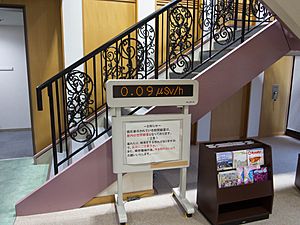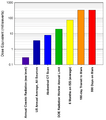Sievert facts for kids
The Sievert, often shortened to Sv, is a special unit used to measure how much ionizing radiation affects living things. It helps us understand the potential harm radiation can cause to a body. This is different from the gray, which measures the total amount of radiation energy absorbed, no matter the type of radiation or its effect.
The Sievert is named after Rolf Maximilian Sievert, a Swedish scientist. He was a physicist and doctor who studied how radiation impacts organisms. His work helped us understand radiation safety better.
Quick facts for kids Sievert |
|
|---|---|
|
Display of background radiation in a hotel at Naraha, Japan, showing dose rate in microsieverts per hour, five years after the Fukushima disaster.
|
|
| General information | |
| Unit system | SI derived unit |
| Unit of | Health effect of ionizing radiation (Equivalent dose) |
| Symbol | Sv |
| Named after | Rolf Maximilian Sievert |
| Conversions | |
| 1 Sv in ... | ... is equal to ... |
| SI base units | m2⋅s−2 |
| Energy absorbed by mass | J⋅kg−1 |
| CGS units (non-SI) | 100 rem |
Contents
What is Ionizing Radiation?
Ionizing radiation is a type of energy that travels in waves or particles. It has enough power to remove electrons from atoms. This process is called "ionization." When atoms in our body become ionized, it can damage cells and DNA.
Where Does Radiation Come From?
Radiation is all around us! It comes from many natural sources. These include rocks, soil, and even space. We also get small amounts from medical X-rays or airport scanners.
How the Sievert Measures Radiation Effect
The Sievert helps us compare the risks from different types of radiation. Not all radiation is equally harmful. For example, a small amount of alpha radiation can be more damaging than the same amount of beta radiation.
Equivalent Dose Explained
The Sievert measures something called "equivalent dose." This dose takes into account:
- The amount of radiation absorbed by the body.
- The type of radiation (like alpha, beta, gamma, or neutrons).
- How sensitive different body parts are to radiation.
It gives us a single number that shows the potential for biological harm.
Sievert in Everyday Life
You might hear about Sieverts when talking about radiation safety. It helps experts set limits for how much radiation people can safely be exposed to. This is important for workers in nuclear power plants or hospitals. It also helps protect the public.
Typical Radiation Doses
Here are some examples of typical radiation doses measured in Sieverts (or smaller units like microsieverts, µSv):
- A chest X-ray might be around 0.1 mSv (millisieverts).
- The average person receives about 2.4 mSv per year from natural background radiation.
- A flight from New York to Tokyo might expose you to about 0.05 mSv. This is due to cosmic radiation at high altitudes.
Protecting Yourself from Radiation
Understanding the Sievert helps us stay safe. Experts use this unit to create rules for radiation protection. These rules help keep people safe in places where radiation is present.
Key Safety Principles
The main ways to reduce radiation exposure are:
- Time: Spend less time near the radiation source.
- Distance: Stay as far away as possible from the source.
- Shielding: Use materials like lead or concrete to block radiation.
These principles help keep radiation doses as low as reasonably achievable.
Images for kids
-
Graphic showing relationship of "protection dose" quantities in SI units
-
Comparison of radiation doses - includes the amount detected on the trip from Earth to Mars by the RAD on the MSL (2011–2013).
See also
 In Spanish: Sievert para niños
In Spanish: Sievert para niños








